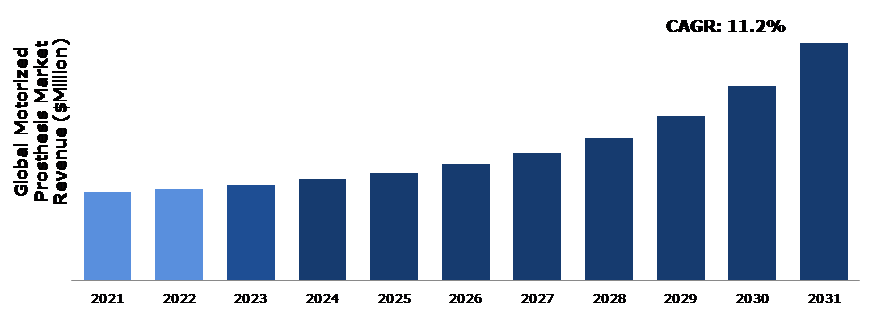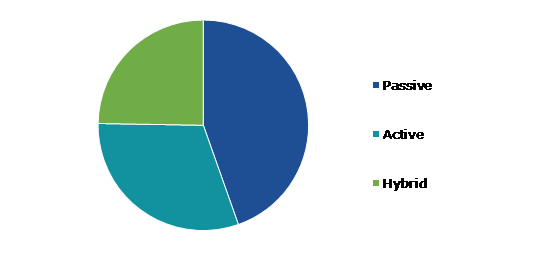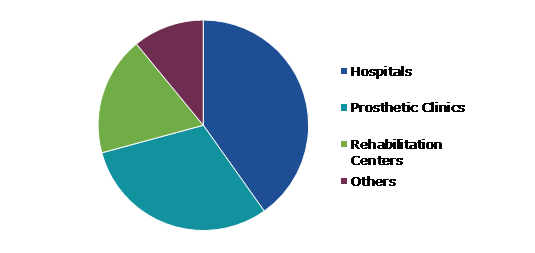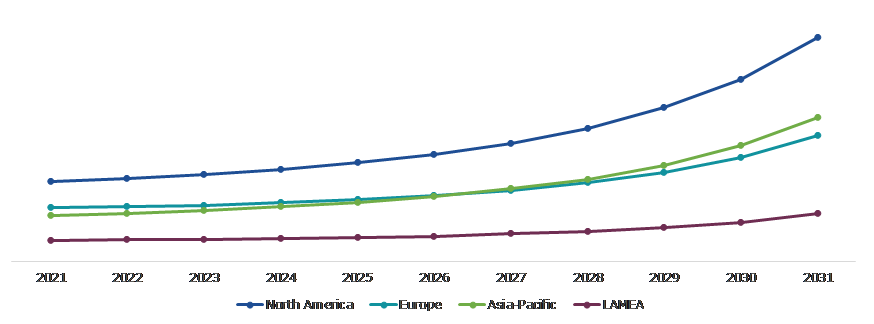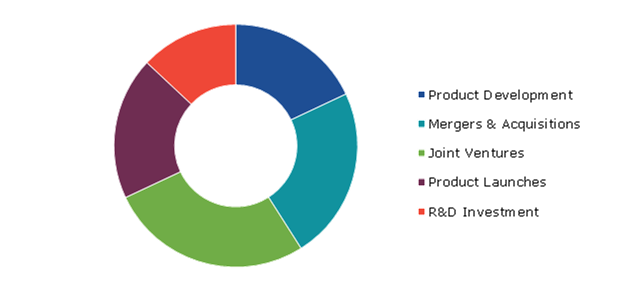Motorized Prosthesis Market Report
RA08620
Motorized Prosthesis Market by Type (Passive, Active, and Hybrid), End-User (Hospitals, Prosthetic Clinics, Rehabilitation Centers, and Others), and Regional Analysis (North America, Europe, Asia-Pacific, and LAMEA): Global Opportunity Analysis and Industry Forecast, 2022–2031
Global Motorized Prosthesis Market Analysis
The Global Motorized Prosthesis Market Size was $57.4 million in 2021 and is predicted to grow with a CAGR of 11.2%, by generating a revenue of $154.1 million by 2031.
Global Motorized Prosthesis Market Synopsis
The surge in demand for motorized prostheses is majorly attributed to the increased rate of amputation on account of injuries, chronic diseases, and genetic diseases. In addition, an upsurge in healthcare spending across the world, the rise in prevalence of joint-related illnesses, and surge in geriatric population worldwide are anticipated to supplement the motorized prosthesis market growth during the forecast period. In the U.S. alone, around 1,50,000 patients every year go through lower extremity amputation. The most common reasons for amputation are peripheral vascular disease, neuropathy, diabetes mellitus, and trauma.
The high cost, however, may hinder the overall motorized prosthesis market growth during the forecast period. In addition, less awareness about motorized prosthesis in developing nations is likely to limit the motorized prosthesis market expansion.
The rise in demand for motorized prostheses for the Paralympic Games is expected to offer ample growth opportunities during the forecast period. For instance, in the Tokyo 2020 Paralympic Games, around 4,400 athletes with disabilities contested using prostheses. The surge in R&D activities has helped athletes get the most out of their athletic ability. Motorized prostheses offer numerous benefits such as durability, training time, frequency of adjustment, and maintenance.
By region, the North America motorized prosthesis market accounted for the highest market share in 2021. The significant demand for motorized prosthesis in this region can be attributed to the factors such as presence of major players, increased spending on advanced technologies, and rise in prevalence of amputations.
Motorized Prosthesis Market Overview
Motorized prostheses offer external power through motors to the amputee. They provide greater performance as well as functionality. In the last several years, numerous active ankle joints, knee joints, and systems combining ankle & knee have been developed by companies. Motorized prostheses are important tools that can restore the ability to pick up & grab objects and help the user’s active hand. Motorized prostheses device offers the physical, societal, and personal betterment of amputees.
COVID-19 Impact on Motorized Prosthesis Market
The coronavirus pandemic harmed the motorized prosthesis market growth. Strict lockdowns, quarantine, and social distancing restrained manufacturing operations and logistics activities, which disrupted the supply chains. As per the World Health Organization (WHO), the organizations operating in the life science R&D area had to function as per the stringent government guidelines with appropriate sanitary measures and social distancing norms. Thus, numerous private research and academic institutes halted or slowed down their research activities.
Research organizations working in life science R&D had to handle their studies with limited resources as they were unable to procure raw materials. The downturn in the world economy during the pandemic declined investment on research and investors delayed their investments. During the COVID-19 pandemic, the governments were more focused on COVID-19 and its vaccine development, owing to which the governments shifted healthcare sector resources toward COVID-19, and hence away from prosthetic sector, resulting in less funding and hampering the growth of the market.
Increased Number of Amputations Worldwide is Expected to Drive the Motorized Prosthesis Market Growth
The increase in number of amputees today is on account of chronic diseases such as cancer and diabetes as well as an increased number of accidents worldwide. The most common reason for amputation is trauma followed by chronic diseases. Lower limb amputation is more common than upper limb amputation. With an increasing number of individuals with diabetes and cancer, the rate of amputation has increased in the last several years. These numbers are expected to further increase with rise in prevalence of such diseases. Motorized prostheses are employed to substitute a lost body part such as the upper limb or lower limb. The amputee by wearing this device can be able to walk, stand, possess balance, and regain upright posture. Therefore, prosthesis is used by an amputee. Motorized prosthesis is most commonly used for lower limb amputation. Lower limb prostheses provide an amputee the opportunity to perform functional tasks majorly walking.
To know more about global motorized prosthesis market drivers, get in touch with our analysts here.
High Cost along with Less Awareness in Developing Nations is Anticipated to Restrain Motorized Prosthesis Market Growth
The high cost of motorized prosthesis may restrain the motorized prosthesis market growth during the forecast period. Despite a substantial demand for these devices, the high cost of these prosthetic devices is a big challenge. An orthotist or prosthetist prescribes a motorized prosthesis that is customized as per the patient's specific requirements. The cost of these devices rises depending on the level of advancement and sophistication. In addition, less demand for motorized prosthesis in developing nations may limit the Motorized Prosthesis market growth.
An Increase in Number of Diabetes-related Amputations is Expected to Offer Excellent Opportunities
Individuals with diabetes are more at risk of requiring lower limb amputation. Ulcers and wounds that do not heal generally cause amputation. Diabetes is connected to two major disorders that increase the probability of foot amputation: diabetic neuropathy and peripheral artery disease (PAD). Diabetic foot ulcers are linked with high morbidity and mortality. Mortality is higher in ischemic ulcers than in neuropathic ulcers. In addition, factors including high blood sugar levels and smoking can augment foot-related complications, which can increase the need for amputation.
To know more about global motorized prosthesis market opportunities, get in touch with our analysts here.
Global Motorized Prosthesis Market, by Type
By type, the market is further divided into passive, active, and hybrid. Among these, the passive segment held the largest market share in 2021 and active segment is anticipated to show the fastest CAGR during the forecast period.
Global Motorized Prosthesis Market Size, by Type, 2021
Source: Research Dive Analysis
The passive segment held the largest market share in 2021. Passive prostheses often consist of prosthetic hands and prosthetic tools. These can either be adjustable as well as static. Many amputees utilize these prosthesis types. Advancement in prosthetic devices offers passive prosthesis a more realistic look and cosmesis to the amputee limb. Passive prosthetic hands give a realistic appearance and can help in a wide range of activities. Prosthetic tools have a robotic impression and are most commonly developed for distinctive activities, which need to be performed with both hands.
The active segment is expected to show the fastest CAGR during the forecast period. Active prostheses offer external power to the user through motors. These prostheses typically provide more functional qualities than passive prostheses. These devices are lightweight and have adequate control techniques for a broad range of locomotor activities. Active prostheses are generally used by individuals with upper limb weakness. Recent amputees and young children have generally been prescribed a passive prosthetic, which is relatively easy to use. After a period of use, these people are expected to use an active prosthesis.
Global Motorized Prosthesis Market, by End-user
By end-user, the global motorized prosthesis market has been divided into hospitals, prosthetic clinics, rehabilitation centers, and others. Among these, the hospitals segment is anticipated to show the fastest CAGR during the forecast period.
Global Motorized Prosthesis Market Share, by End-user, 2021
Source: Research Dive Analysis
The hospitals segment is expected to have the fastest growth during the forecast period. Mostly motorized prostheses are prescribed by hospitals. Most Government-approved prostheses are covered by hospital cover. The hospitals prescribe motorized prostheses who have undergone amputation. Hospitals also provide other services such as the maintenance and repair of artificial limbs by a team of experts.
Global Motorized Prosthesis Market, Regional Insights
The motorized prosthesis market is analyzed across North America, Europe, Asia-Pacific, and LAMEA.
Global Motorized Prosthesis Market Size & Forecast, by Region, 2021-2031 ($ Million)
Source: Research Dive Analysis
North America Region Dominated the Motorized Prosthesis Market in 2021
The North America region dominated the global motorized prosthesis market in 2021. The rise in demand for motorized prostheses in this region is majorly attributed to the presence of major players, increase in healthcare spending, the prevalence of chronic diseases such as cancer & diabetes, well-established healthcare infrastructure, and favorable government support. Moreover, the growing prevalence of accidents is further boosting market expansion. In the U.S., diabetes has increased rapidly in the last few years. As per the National Diabetes Statistics Report (2020), around 34.2 million people in the U.S. have diabetes. The rise in prevalence of diabetes is majorly attributed to genetics as well as unhealthy eating patterns and lack of exercise. In severe diabetic cases, the patient needs to undergo amputation.
Global Motorized Prosthesis Market Competitive Scenario
Joint ventures, investment, merger & acquisition, product development, and technological development are the common strategies followed by major motorized prosthesis market players. For instance, in 2021, Cleveland Clinic researchers developed bionic arm that restores natural behaviors in amputees with upper limb amputations. This is a first-of-its-kind bionic arm for patients with upper-limb amputations that lets amputees feel, behave, and function like a person without an amputation.
Source: Research Dive Analysis
Some of the leading players in Motorized Prosthesis market are Arm Dynamics, Bionic Prosthetics, Orthotics, BionX Medical Technologies, Inc., Faulhaber Group, Freedom Innovations, LLC, Mobius Bionics LLC, Össur hf., Otto Bock HealthCare GmbH, and Sensars Neuroprosthteics.
| Aspect | Particulars |
| Historical Market Estimations | 2020 |
| Base Year for Market Estimation | 2021 |
| Forecast timeline for Market Projection | 2022-2031 |
| Geographical Scope | North America, Europe, Asia-Pacific, and LAMEA |
| Segmentation by Type
|
|
| Segmentation by End-User |
|
| Key Companies Profiled |
|
Q1. What is the size of the Motorized Prosthesis market?
A. The global motorized prosthesis market size was over $57.4 million in 2021 ¬¬and is anticipated to reach $154.1 million by 2031.
Q2. Which are the leading companies in the Motorized Prosthesis market?
A. Össur hf., Faulhaber Group, and Arm Dynamics are some of the key players in the global Motorized Prosthesis market.
Q3. Which region is expected to possess greater investment opportunities in the coming future?
A. Asia-Pacific is expected to possess greater investment opportunities for investors to witness the most promising market growth in the coming years.
Q4. What is the growth rate of the Asia-Pacific market?
A. The Asia-Pacific Motorized Prosthesis market is anticipated to grow at 12.9% CAGR during the forecast period.
Q5. What are the strategies opted by the leading players in this market?
A. Product innovations, business expansions, and technological advancements are the key strategies opted by the operating companies in this market.
Q6. Which companies are investing more on R&D practices?
A. Mobius Bionics LLC, Orthotics, and Bionic Prosthetics are investing more on R&D activities for developing new products and technologies.
1.Research Methodology
1.1.Desk Research
1.2.Real time insights and validation
1.3.Forecast model
1.4.Assumptions and forecast parameters
1.5.Market size estimation
1.5.1.Top-down approach
1.5.2.Bottom-up approach
2.Report Scope
2.1.Market definition
2.2.Key objectives of the study
2.3.Report overview
2.4.Market segmentation
2.5.Overview of the impact of COVID-19 on Global motorized prosthesis market
3.Executive Summary
4.Market Overview
4.1.Introduction
4.2.Growth impact forces
4.2.1.Drivers
4.2.2.Restraints
4.2.3.Opportunities
4.3.Market value chain analysis
4.3.1.List of raw material suppliers
4.3.2.List of manufacturers
4.3.3.List of distributors
4.4.Innovation & sustainability matrices
4.4.1.Technology matrix
4.4.2.Regulatory matrix
4.5.Porter’s five forces analysis
4.5.1.Bargaining power of suppliers
4.5.2.Bargaining power of consumers
4.5.3.Threat of substitutes
4.5.4.Threat of new entrants
4.5.5.Competitive rivalry intensity
4.6.PESTLE analysis
4.6.1.Political
4.6.2.Economical
4.6.3.Social
4.6.4.Technological
4.6.5.Environmental
4.7.Impact of COVID-19 on Motorized Prosthesis market
4.7.1.Pre-covid market scenario
4.7.2.Post-covid market scenario
5.Motorized Prosthesis Market Analysis, by Type
5.1.Overview
5.2.Passive
5.2.1.Definition, key trends, growth factors, and opportunities
5.2.2.Market size analysis, by region, 2021-2031
5.2.3.Market share analysis, by country, 2021-2031
5.3.Active
5.3.1.Definition, key trends, growth factors, and opportunities
5.3.2.Market size analysis, by region, 2021-2031
5.3.3.Market share analysis, by country, 2021-2031
5.4.Hybrid
5.4.1.Definition, key trends, growth factors, and opportunities
5.4.2.Market size analysis, by region, 2021-2031
5.4.3.Market share analysis, by country, 2021-2031
5.5.Research Dive Exclusive Insights
5.5.1.Market attractiveness
5.5.2.Competition heatmap
6.Motorized Prosthesis Market Analysis, by End-user
6.1.Hospitals
6.1.1.Definition, key trends, growth factors, and opportunities
6.1.2.Market size analysis, by region, 2021-2031
6.1.3.Market share analysis, by country, 2021-2031
6.2.Prosthetic Clinics
6.2.1.Definition, key trends, growth factors, and opportunities
6.2.2.Market size analysis, by region, 2021-2031
6.2.3.Market share analysis, by country, 2021-2031
6.3.Rehabilitation Centers
6.3.1.Definition, key trends, growth factors, and opportunities
6.3.2.Market size analysis, by region, 2021-2031
6.3.3.Market share analysis, by country, 2021-2031
6.4.Others
6.4.1.Definition, key trends, growth factors, and opportunities
6.4.2.Market size analysis, by region, 2021-2031
6.4.3.Market share analysis, by country, 2021-2031
6.5.Research Dive Exclusive Insights
6.5.1.Market attractiveness
6.5.2.Competition heatmap
7.Motorized Prosthesis Market, by Region
7.1.North America
7.1.1.U.S.
7.1.1.1.Market size analysis, by Type, 2021-2031
7.1.1.2.Market size analysis, by End-user, 2021-2031
7.1.2.Canada
7.1.2.1.Market size analysis, by Type, 2021-2031
7.1.2.2.Market size analysis, by End-user, 2021-2031
7.1.3.Mexico
7.1.3.1.Market size analysis, by Type, 2021-2031
7.1.3.2.Market size analysis, by End-user, 2021-2031
7.1.4.Research Dive Exclusive Insights
7.1.4.1.Market attractiveness
7.1.4.2.Competition heatmap
7.2.Europe
7.2.1.Germany
7.2.1.1.Market size analysis, by Type, 2021-2031
7.2.1.2.Market size analysis, by End-user, 2021-2031
7.2.2.UK
7.2.2.1.Market size analysis, by Type, 2021-2031
7.2.2.2.Market size analysis, by End-user, 2021-2031
7.2.3.France
7.2.3.1.Market size analysis, by Type, 2021-2031
7.2.3.2.Market size analysis, by End-user, 2021-2031
7.2.4.Switzerland
7.2.4.1.Market size analysis, by Type, 2021-2031
7.2.4.2.Market size analysis, by End-user, 2021-2031
7.2.5.Italy
7.2.5.1.Market size analysis, by Type, 2021-2031
7.2.5.2.Market size analysis, by End-user, 2021-2031
7.2.6.Russia
7.2.6.1.Market size analysis, by Type, 2021-2031
7.2.6.2.Market size analysis, by End-user, 2021-2031
7.2.7.Rest of Europe
7.2.7.1.Market size analysis, by Type, 2021-2031
7.2.7.2.Market size analysis, by End-user, 2021-2031
7.2.8.Research Dive Exclusive Insights
7.2.8.1.Market attractiveness
7.2.8.2.Competition heatmap
7.3.Asia Pacific
7.3.1.China
7.3.1.1.Market size analysis, by Type, 2021-2031
7.3.1.2.Market size analysis, by End-user, 2021-2031
7.3.2.Japan
7.3.2.1.Market size analysis, by Type, 2021-2031
7.3.2.2.Market size analysis, by End-user, 2021-2031
7.3.3.India
7.3.3.1.Market size analysis, by Type, 2021-2031
7.3.3.2.Market size analysis, by End-user, 2021-2031
7.3.4.Australia
7.3.4.1.Market size analysis, by Type, 2021-2031
7.3.4.2.Market size analysis, by End-user, 2021-2031
7.3.5.South Korea
7.3.5.1.Market size analysis, by Type, 2021-2031
7.3.5.2.Market size analysis, by End-user, 2021-2031
7.3.6.Rest of Asia Pacific
7.3.6.1.Market size analysis, by Type, 2021-2031
7.3.6.2.Market size analysis, by End-user, 2021-2031
7.3.7.Research Dive Exclusive Insights
7.3.7.1.Market attractiveness
7.3.7.2.Competition heatmap
7.4.LAMEA
7.4.1.Brazil
7.4.1.1.Market size analysis, by Type, 2021-2031
7.4.1.2.Market size analysis, by End-user, 2021-2031
7.4.2.Saudi Arabia
7.4.2.1.Market size analysis, by Type, 2021-2031
7.4.2.2.Market size analysis, by End-user, 2021-2031
7.4.3.UAE
7.4.3.1.Market size analysis, by Type, 2021-2031
7.4.3.2.Market size analysis, by End-user, 2021-2031
7.4.4.South Africa
7.4.4.1.Market size analysis, by Type, 2021-2031
7.4.4.2.Market size analysis, by End-user, 2021-2031
7.4.5.Rest of LAMEA
7.4.5.1.Market size analysis, by Type, 2021-2031
7.4.5.2.Market size analysis, by End-user, 2021-2031
7.4.6.Research Dive Exclusive Insights
7.4.6.1.Market attractiveness
7.4.6.2.Competition heatmap
8.Competitive Landscape
8.1.Top winning strategies, 2021
8.1.1.By strategy
8.1.2.By year
8.2.Strategic overview
8.3.Market share analysis, 2021
9.Company Profiles
9.1.Arm Dynamics
9.1.1.Overview
9.1.2.Business segments
9.1.3.Product portfolio
9.1.4.Financial performance
9.1.5.Recent developments
9.1.6.SWOT analysis
9.2.Bionic Prosthetics
9.2.1.Overview
9.2.2.Business segments
9.2.3.Product portfolio
9.2.4.Financial performance
9.2.5.Recent developments
9.2.6.SWOT analysis
9.3.Orthotics
9.3.1.Overview
9.3.2.Business segments
9.3.3.Product portfolio
9.3.4.Financial performance
9.3.5.Recent developments
9.3.6.SWOT analysis
9.4.BionX Medical Technologies, Inc.
9.4.1.Overview
9.4.2.Business segments
9.4.3.Product portfolio
9.4.4.Financial performance
9.4.5.Recent developments
9.4.6.SWOT analysis
9.5.Faulhaber Group
9.5.1.Overview
9.5.2.Business segments
9.5.3.Product portfolio
9.5.4.Financial performance
9.5.5.Recent developments
9.5.6.SWOT analysis
9.6.Freedom Innovations, LLC
9.6.1.Overview
9.6.2.Business segments
9.6.3.Product portfolio
9.6.4.Financial performance
9.6.5.Recent developments
9.6.6.SWOT analysis
9.7.Mobius Bionics LLC
9.7.1.Overview
9.7.2.Business segments
9.7.3.Product portfolio
9.7.4.Financial performance
9.7.5.Recent developments
9.7.6.SWOT analysis
9.8.Össur hf.
9.8.1.Overview
9.8.2.Business segments
9.8.3.Product portfolio
9.8.4.Financial performance
9.8.5.Recent developments
9.8.6.SWOT analysis
9.9.Otto Bock HealthCare GmbH
9.9.1.Overview
9.9.2.Business segments
9.9.3.Product portfolio
9.9.4.Financial performance
9.9.5.Recent developments
9.9.6.SWOT analysis
9.10.Sensars Neuroprosthteics
9.10.1.Overview
9.10.2.Business segments
9.10.3.Product portfolio
9.10.4.Financial performance
9.10.5.Recent developments
9.10.6.SWOT analysis
Motorized prostheses have come a long way since their inception. They are designed to help amputees regain the freedom and mobility they may have lost due to injury, diseases, or other reasons. The earliest motorized prostheses were bulky and heavy, and their movements were often jerky and unnatural. However, advances in technology have made it possible to create prostheses that are lightweight, durable, and highly responsive to the user’s movements. One of the key features of a motorized prosthesis is the use of electrical motors. These motors provide the power necessary to move the prosthetic limb, and they are controlled by sensors that detect the user’s movements. The sensors can detect muscle contractions and translate those contractions into movements of the prosthesis.
Forecast Analysis of the Global Motorized Prosthesis Market
With the growing rate of amputations across the globe due to the increasing prevalence of chronic diseases among individuals such as diabetes and cancer, the motorized prosthesis market is predicted to witness remarkable growth over the forecast period. Moreover, the increasing need for amputations owing to the rising foot-related complications caused by high blood sugar levels and smoking is further expected to bolster the growth of the market throughout the estimated timeframe. However, the high cost of motorized prostheses along with the less awareness about it among people in developing nations may restrict the growth of the market over the analysis period.
According to the report published by Research Dive, the global motorized prosthesis market is predicted to garner $154.1 million revenue by 2031 and grow at a CAGR of 11.2% during the forecast timeframe from 2022 to 2031. The major players of the market include Sensars Neuroprosthetics, Arm Dynamics, Otto Bock HealthCare GmbH, Bionic Prosthetics, Össur hf., Orthotics, Mobius Bionics LLC, BionX Medical Technologies, Inc., Mobius Bionics LLC, Faulhaber Group, Freedom Innovations, LLC, and many more.
Key Developments
The key companies operating in the industry are adopting various growth strategies & business tactics such as partnerships, collaborations, mergers & acquisitions, and launches to maintain a robust position in the overall market, which is subsequently helping the global motorized prosthesis market to grow exponentially. For instance:
- In September 2021, Cleveland Clinic-led international research team engineered a first-of-its-kind bionic arm for patients with upper-limb amputations, in collaboration with the University of Alberta and the University of New Brunswick. This bionic arm can allow the wearer to think, behave, and function like a human without an amputation.
- In September 2022, Össur, a renowned leader in the orthotics and prosthetics (O&P) industry launched its new product namely, POWER KNEE which is the world’s first actively powered microprocessor prosthetic knee for individuals with limb differences. POWER KNEE is a motor-powered "smart" prosthesis that utilizes advanced algorithms to find human movement patterns, learn, and adjust to its wearer's speed and cadence in real time.
- In December 2022, EQT, a private equity firm, announced its acquisition of Ottobock, a German prosthetics company. With this acquisition, Ottobock aimed to expand its portfolio by developing more advanced motorized prostheses that can be controlled by users’ thoughts.
Most Productive Region
The North America region of the motorized prosthesis market registered the highest revenue in 2021 and is anticipated to have steady growth in the coming period. This is mainly due to the robust presence of major market players, rising healthcare spending, and the increasing pervasiveness of chronic diseases among people of this region. Additionally, the rising cases of accidents in this region are expected to thrive the regional growth of the market over the estimated timeframe.
Covid-19 Impact on the Global Motorized Prosthesis Market
The rise of the Covid-19 pandemic has harshly affected the motorized prosthesis market, likewise various other industries. Prolonged quarantine period, strict lockdowns, and social distancing norms have hampered the manufacturing and logistics activities during the pandemic. This further disrupted the supply chain of raw materials. In addition, the governments paid more attention to the development of the Covid-19 vaccines which has reduced investments in R&D activities. All these factors have severely decreased the market growth over the crisis period.
Personalize this research
- Triangulate with your own data
- Request your format and definition
- Get a deeper dive on a specific application, geography, customer or competitor
- + 1-888-961-4454 Toll - Free
- support@researchdive.com

